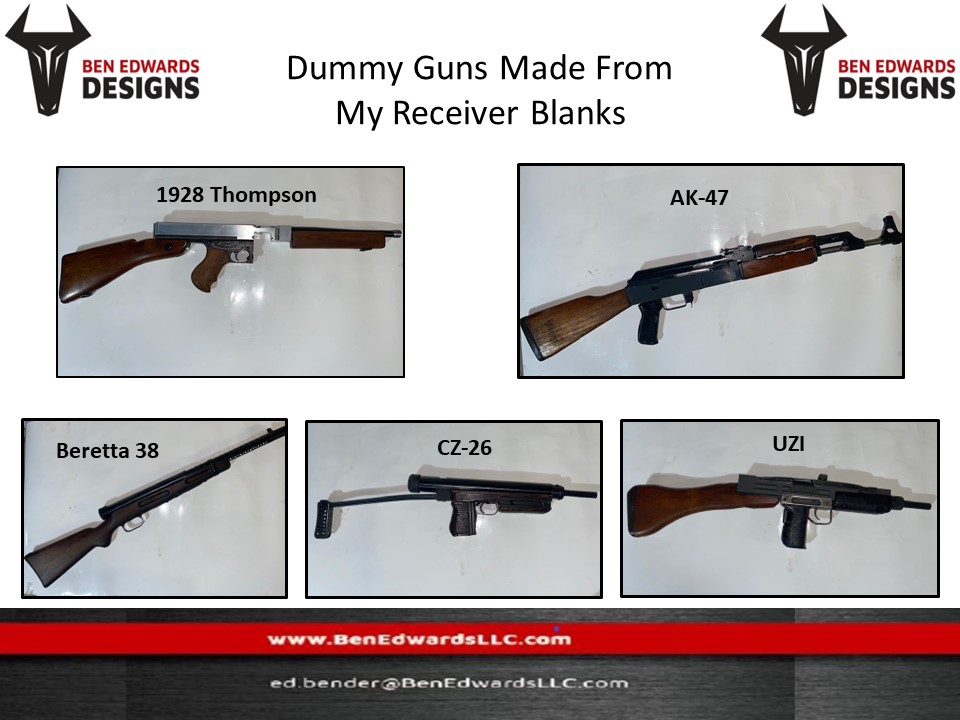Description
Designed with the help of an AK expert and printed with PLA Pro +, for added strength from the Creatbot DX Plus to hold +/-.001” from the 3d model. These AK Billet 3D Printed Display Receiver will accept the needed parts to build a dummy gun at a fraction of the price of ones made from steel. Please note these are made to order and will ship 1 week after your order date. No FFL needed.
Ben Edwards Designs Product Catalog
Background
During World War II, the German Sturmgewehr 44 rifle caught the attention of Soviet forces. Its select-fire capabilities and 7.92×33mm Kurz intermediate cartridge combined the range and accuracy of a rifle with the firepower of a submachine gun. In response, the Soviet Union developed their own intermediate caliber fully automatic rifle using the 7.62×39mm M43 cartridge, which was used in the semi-automatic SKS carbine and the RPD light machine gun.
Following the war, the AK-47 rifle was developed by the Soviets and quickly replaced the SKS in their service. The AKM, a lighter stamped steel version, was introduced in 1959 and became the most widespread variant of the AK series. In the 1960s, the Soviets developed the RPK light machine gun, an AK type weapon with a stronger milled receiver, longer heavy barrel, and bipod, which eventually replaced the RPD light machine gun. In contrast to the milled receiver, there are also dummy receivers used in some AK-47 replicas for display or training purposes.
Service life
The AK-47 and its various models are manufactured in many countries with differing levels of quality, ranging from high-quality craftsmanship to shoddy workmanship. These rifles generally have a service/system life of 6,000 to 10,000 to 15,000 rounds. The AK-47 was designed to be a cheap and simple rifle that was easy to manufacture, which aligns with Soviet military doctrine that treats equipment and weapons as disposable items. Units often operate without sufficient logistical support and rely on cannibalizing weapons from the battlefield for resupply, making it more cost-effective to replace rather than repair weapons.
The AK-47 has small parts and springs that need to be replaced every few thousand rounds. However, every time it is disassembled beyond field stripping, some parts may lose their fit, tend to shake loose, or fall out while firing. Certain parts of the AK-47 are riveted together, making repairs complicated since the end of the rivet must be ground off and a new one must be set after the part is replaced.
Technical Information
| Place of origin | Soviet Union |
| Service history | |
| In service | 1949–1974 (Soviet Union) |
| 1949–present (other countries) | |
| Used by | See Users |
| Wars | See Conflicts |
| Production history | |
| Designer | Mikhail Kalashnikov |
| Designed | 1946–1948 |
| Manufacturer | Kalashnikov Concern and various others including Norinco |
| Produced | 1948–present |
| No. built | ≈ 75 million AK-47s, 100 million Kalashnikov-family weapons. |
| Variants | See Variants |
| Specifications (AK-47 with Type 3 receiver) | |
| Mass | Without magazine: |
| 3.47 kg (7.7 lb) | |
| Magazine, empty: | |
| 0.43 kg (0.95 lb) (early issue) | |
| 0.33 kg (0.73 lb) (steel) | |
| 0.25 kg (0.55 lb) (plastic) | |
| 0.17 kg (0.37 lb) (light alloy) | |
| Length | Fixed wooden stock: |
| 880 mm (35 in) | |
| 875 mm (34.4 in) folding stock extended | |
| 645 mm (25.4 in) stock folded | |
| Barrel length | Overall length: |
| 415 mm (16.3 in) | |
| Rifled bore length: | |
| 369 mm (14.5 in) | |
| Cartridge | 7.62×39mm |
| Action | Gas-operated, closed rotating bolt |
| Rate of fire | Cyclic rate of fire: |
| 600 rds/min | |
| Combat rate of fire: | |
| Semi-auto 40 rds/min | |
| Bursts 100 rds/min | |
| Muzzle velocity | 715 m/s (2,350 ft/s) |
| Effective firing range | 350 m (380 yd) |
| Feed system | 20-round, 30-round detachable box magazine |
| There are also 40-round, 75-round drum magazines available | |
| Sights | 100–800 m adjustable iron sights |
| Sight radius: | |
| 378 mm (14.9 in) | |






Reviews
There are no reviews yet.